#white skin immigration policies
Explore tagged Tumblr posts
Text
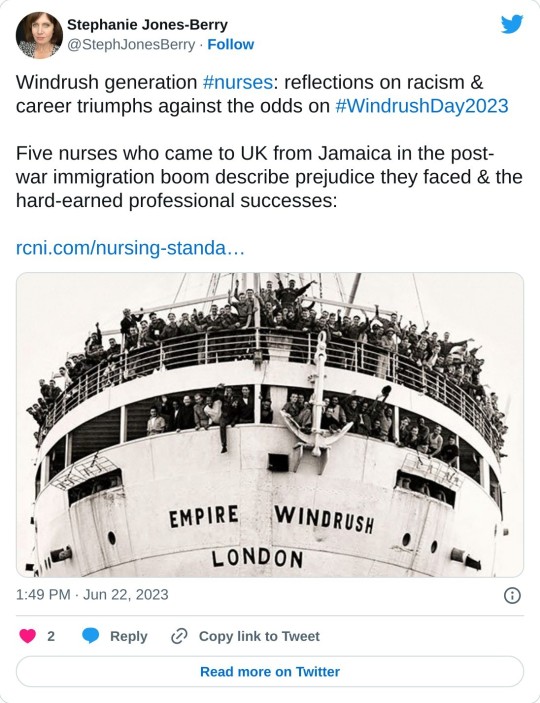
Action is needed to show nurses of colour that their contribution is valued and their lives matter, as opposed to words, nursing leaders have warned on the third annual Windrush Day.
On this day in 1948, the first group of people arrived in Essex from the Caribbean on the Empire Windrush cruise ship, pictured above, answering the UK’s call for public sector workers following the Second World War.
“There is still so much to do to level the playing field for people of colour in the UK" Trevor Sterling
Many of these passengers and the other members of the Windrush Generation – along with their descendants – were or would go on to become nurses, helping to create the National Health Service.
The government announced in 2018 that 22 July would become an annual holiday to celebrate the British-Caribbean community and to thank those who helped to rebuild Britain after the war.
The designation came in the wake of the Windrush Scandal in which stories of Commonwealth citizens being wrongfully detained, deported and denied their rights came to light.
Windrush Day this year is particularly poignant as it coincides with a time of national and international reflection on the racial inequalities in our society brought to stark attention by Covid-19 and the Black Lives Matters movement.
More on this topic:
Workplace racism linked to BAME nurses’ higher virus risk
Action on BAME nurse risks coming, minister tells Nursing Times
Nurses from Asian backgrounds at highest Covid-19 risk, finds PHE review
‘Covid-19 and Black Lives Matter have placed racism in the spotlight’
High death rates among Filipino nurses in UK now on global radar
BAME groups at ‘higher risk’ of getting Covid-19 with deprivation among factors
Exclusive: BME nurses ‘feel targeted’ to work on Covid-19 wards
NHS leaders set out new measures to protect BME staff in pandemic
Professor Greta Westwood, chief executive of the Florence Nightingale Foundation, said more needed to be done to “redress the current imbalance” in nursing in terms of race.
While 20% of the overall NHS nursing and midwifery workforce in England is from a black, Asian or ethnic minority (BAME) background, the percentage reduces to 4% for director-level nursing posts.
“It saddens me today to see that our BAME staff, whose own ancestors helped to build the NHS, still feel that they have to break through glass ceilings to succeed,” said Professor Westwood.

Greta Westwood
The foundation launched the Windrush Leadership Programme to help BAME nurses at bands 5 to 6 reach senior leadership positions and now also runs Windrush Leadership Scholarships.
Some of the BAME nurses and midwives who applied to the programme had been in their band 5 roles for more than 20 years.
“Since its foundation, the Windrush Leadership Programme has helped BAME staff find their voice and rightfully claim their place as senior leaders in the NHS,” added Professor Westwood.
“I urge my fellow NHS and other healthcare leaders to redress the current imbalance. We as the foundation will continue to foster this talent, but it is our collective responsibility to work together. Action not words create change.”
One Windrush scholar, Deborah Hylton, said when she joined the programme, she was working as a band 6 health visitor and was struggling with “self-doubt” after being continuously turned down for band 7 roles.
Inspired by her sister and sister-in-law who both came to the UK from the Caribbean when she was 13 and trained as nurses, Ms Hylton joined the nursing profession as a mature student with two young children to “give back to my community”.
She said the “confidence and skills” she gained through the course helped her to secure her current role as a lecturer in children’s nursing at London South Bank University.
“I am now in a position where I can encourage student nurses from all ethnic groups that nothing is impossible. I am able to stand in front of them as their lecturer and role model and make them aware of another career direction that nursing can offer,” said Ms Hylton.
Meanwhile, staff from four London hospitals will tonight mark Windrush Day by gathering outside their buildings at 5pm and taking a knee to show solidarity with the Black Lives Matter movement.
The protest will be observed by workers at St Thomas Hospital, Kings College Hospital, South London and Maudsley Hospitals, and Lewisham University Hospital.
The action is being organised by Unite the union at Guy's and St Thomas' NHS Foundation Trust, and Royal College of Nursing Inner South East London.
Mark Boothroyd, Unite branch secretary for Guy's and St Thomas', said: “The NHS has the same problems of systemic racism as every other part of society.
“With over 50% of nursing staff in London being from BME backgrounds and directly affected by this, its important staff can show their support for Black Lives Matter, and push their own employers to make changes to tackle the ongoing issue of racism in the NHS.”
The RCN is also using Windrush Day to urge the Home Office to grant indefinite leave to remain to all international health and care workers who have worked in the UK during the pandemic.
“The NHS has the same problems of systemic racism as every other part of society" Mark Boothroyd
Dame Donna Kinnair, RCN chief executive and general secretary, said: “The best way to honour the legacy of Windrush Day is to ensure no nurse, or health and care worker, who trained overseas, and helped in this pandemic, feels alien in this country.
“Granting automatic, indefinite leave to remain to international health and care workers who helped tackle this virus should be instinctive.
“The services and support that they provide, though brought to the fore through this pandemic, have always been essential. They are, and always will be, key workers.”
More than one in 10 of the total registered nursing workforce in the UK come from overseas, according to the Nursing and Midwifery Council. As of September 2019, 77,065 registered nurses came from outside the European Economic Area.
However, international nursing staff must wait five years before they can apply for indefinite leave to remain and are required to take a test to prove their Britishness before they are granted it.

Donna Kinnair
Another organisation demanding action over words is the Mary Seacole Trust which exists to educate the public about the life of the British-Jamaican nursing pioneer who cared for soldiers during the Crimean War, working against both racism and sexism.
The trust oversaw the creation of a Mary Seacole statue in 2016 in the grounds of St Thomas' Hospital, becoming the first statue in the UK in honour of a named black woman.
To mark Windrush Day, the organisation is calling for a national “black plaque scheme” to educate the public on UK black history.
It has written to the prime minister and London mayor to request that plaques are put up next to all British statues to explain the historical context, with the wording decided in collaboration with members of the black community.
Trevor Sterling, chair of the Mary Seacole Trust, said: “Windrush Day has a huge significance for me, my family and countless other black people in the UK.

Trevor Sterling
“Since the Empire Windrush docked at Tilbury in 1948, we have been contributing to our communities in Britain, and yet like Mary Seacole, our contributions are not fully recognised.
“There is still so much to do to level the playing field for people of colour in the UK, as seen most recently in the disproportionate number of BAME coronavirus deaths.
“Education about black British history must be central to all policy changes. If we are to truly address racism in the UK, we must first educate British citizens."
#empire windrush#windrush generation#nurses of the windrush#english immigration#Windrush Day: Nurses demand action on racism and inequality#racial inequality in england#uk racism#white skin immigration policies#BAME
8 notes
·
View notes
Note
In the Blacked Denmark that you so beautifully describe, a third of the population are made up of young Black Men. They will immediately get full voting rights – anything else would be racist – and this makes them, on their own, a huge part of the voting population. When we add in the Snowbunny vote – I guess 90%+ of Danish women from 18 to 50 will soon be regularly parting their white thighs for the new arrivals, and keen to please them in the voting booths as well as in the bedroom – and the votes of white guys who (under the influence of blogs like yours) welcome this new world, this makes up a clear majority, more than enough to counter any racist parties opposed to progress.
What laws would a Blacked parliament pass for the new Denmark? This is a real opportunity to establish the BNWO with new laws about political participation, property rights, the workplace, education, sex . . . I have some ideas but would love to hear yours.
(Follow-up to this post.)
The Racial Justice Party soon emerges to break up the Danish political scene. It will be headed by a charismatic Black man who is as ready to cite Malcolm X and W.E.B. Du Bois in interviews as he is to pose with a sledge-hammer raised high above his head - a powerful manifestation of his vow to "smash white nationalism".
The party will be supported by all of the young Black men - a third of the population, as you point out - and by about half of the indiginous Danish population - mostly women, but also by progress-minded men.

The party surges into Parliament, forming a one-party government with a solid majority.
On the eve of the election, the new Minister of State announces the first promise of the new government: To put an end to the racist immigration policy of "Old Denmark" and fling open the gates to Africa. More dark-skinned men will be arriving at the Danish shores - a lot more.

The day after, the second promise is announced: Denmark will be contributing heavily to global reparations, funded with a new tax levied only on ethnically Danish people.
In the coming weeks, a flurry of legislation followers, including:
Racial Justice in Urban Planning, in which statues of the luminaries of Old Denmark (Hans Christian Andersen and Søren Kierkegaard) are torn down and replaced by statues of George Floyd and Martin Luther King.
Racial Justice in Land Ownership, in which land is redistributed, making sure fertile farm land ends up in the hands of the new arrivals.
Racial Justice in Education, in which curricula are Africanized - as described here and elsewhere on my blog.

92 notes
·
View notes
Text

The Whitening of Brazil
Brazil has a long and painful history of slavery that impacted its racial composition. In 1888, the country became the last in the Western Hemisphere to abolish slavery. During the more than 300 years of slavery in the Americas, Brazil was the largest importer of enslaved Africans. According to a UN publication by Edward Telles, Brazil brought in seven times as many as the United States. This massive influx of enslaved Africans resulted in a predominantly Black and mixed-race population by the time of abolition.
From the 1930s until recent years, Brazil promoted the idea of being a “racial democracy.” This concept suggested that racism and racial discrimination were minimal or non-existent in Brazilian society, especially when compared to other multiracial societies like the United States or South Africa. The absence of explicit race-based laws or policies, such as segregation or apartheid, throughout the 20th century reinforced this belief.
However, this ideology masked underlying racial inequalities and discrimination that persisted in Brazilian society. In the late 19th and early 20th centuries, Brazilian officials actively encouraged European immigration while restricting Chinese and African immigrants. This policy was rooted in the scientific racism of the time, which viewed a non-white population as problematic for the country’s future development.
Blanqueamiento is a social, political, and economic practice used to "improve the race" towards a supposed ideal of whiteness.
Biologically, blanqueamiento could be achieved by marrying a lighter-skinned individual to produce lighter-skinned offspring.
•••
El Blanqueamiento de Brazil
Brazil tiene una historia de racismo larga y dolorosa, la cual ha impactado su composición racial. En 1888, el país fue el último país del hemisferio occidental en derogar la esclavitud. Durante más de trescientos años de esclavitud en las Americas, Brazil fue el importador más grande de africanos esclavizados. De acuerdo con una publicación realizada por las Naciones Unidas, escrita por Edward Telles, Brazil traía siete veces más que los Estados Unidos. Para el momento que llegó la derogación, esta entrada masiva de africanos esclavizados resultó en una población predominantemente negra o de raza mezclada.
Desde la década de 1930 hasta años recientes, Brazil promovía la idea de ser una “democracia racial”. Este concepto sugería que el racismo y la discriminación racial eran bajos o no existía en la sociedad de Brazil, especialmente comparada con otras sociedades multirraciales como Estados Unidos o Sudáfrica. La falta de leyes o políticas explícitas y basadas en la raza como lo son el apartheid o la segregación racial, hizo que a lo largo de el siglo XX, esta creencia se fortaleciera.
Sin embargo, esta ideología enmascaraba desigualdad y discriminación racial, que persistió en la sociedad brasileña. A finales del siglo XIX y principios del siglo XX, las autoridades brasileñas promovían la inmigración de europeos y restringieron a los inmigrantes africanos y chinos. Esta política estaba basada en el racismo científico de ese entonces, el cual consideraba que una población no blanca sería problemático para el futuro desarrollo del país.
Blanqueamiento es una práctica social, política y económica, utilizada para “mejorar la raza” y para alcanzar la blanquitud ideal.
Biológicamente, el blanqueamiento podría lograrse casándose con un individuo de piel más clara para producir descendencia de piel clara.
#blacklivesmatter#blacklivesalwaysmatter#blackhistory#history#blackhistorymonth#blackpeoplematter#black history is everybody's history#black history matters#brasil#brazil#black history#historyfacts#black history is world history#african history#knowyourhistory#blackhistoryyear#black history month#black lives are important#black lives matter#blackownedandoperated#black owned#culture#racial#share#whitening#the more you know#blackbloggers#black history 2024#read#segregation
29 notes
·
View notes
Text
the biggest mistake that white americans make is to think that people south of their border don't think of themselves as white, that there's only one conception of whiteness which exists independently of class and citizenship status, and therefore they aren't willing to coopt policies that discriminate against other immigrants on the basis of a racial hierarchy particular to these qualities, regardless of any difference in skin tone
33 notes
·
View notes
Text
There are many things I don’t understand about this country, how people can be so rooted in their ways with such hatred that people would rather vote for a criminal than for a woman. In the 21st century non the less. It hurts my heart as a woman to live in this country, and though I’m grateful to live in a state where abortions are still legal and still protected I fear for my friends and family who aren’t.
As an 18 year old I shouldn’t have to live in a constant fear of my own body, I shouldn’t have to live in the terrorizing dreadful anxiety of not being able to receive the healthcare I might need. I’m genetically predisposed to have liver and kidney failure if I become pregnant, wanted or unwanted pregnancy is unsafe and can kill me. And even if someone isn’t genetically predisposed to any risks it’s still dangerous. Everything about being pregnant is dangerous and traumatic.
My grandparents and parents are immigrants, my siblings and I are first generation. My parents escaped wars only to find themselves too old to leave one again. Iran is a war place, I cannot go there. Germany, maybe but I can’t request my parents to pack up and leave everything behind.
I’m disappointed in this country, to the people who voted for Trump under the guise that he may fix the economy, remember when he was president? When the world stopped turning and COVID hit. When he undid policies that would’ve prevented that spread. If you’re voting for him thinking he will protect you, and your family. He will not, he will push you out of your country if your skin isn’t white enough and your hair isn’t blonde.
The land of the free has slowly turned into the land of the captured, we have closed the country of kindness. Turned our world into a place of hatred, a place where no one is safe. This year standing at the ballot I felt pride to vote for Harris and Waltz. I felt pride to try and help my country.
It saddens me, driving on the freeway and seeing “TRUMP VANCE 2024” on the side of a car. But what hurts even more is seeing a woman driving. To see a woman actively voting to take away her own rights. To listen to someone falsely lie and spread misinformation about immigrants.
I am hurt, not only as a us citizen. But as a woman.
#louiseabilenewrites#vote vote vote#vote 2024#vote kamala#kamala harris#kamala 2024#kamala for president#trump stinks#dump trump#biggest trump hater in the us#abortion#women’s rights#immigration#politics#election 2024#us elections#presidential election
18 notes
·
View notes
Text
I don't really like talking about politics on the permanent, infinite void that is the internet, but I feel like right now with the situation in my country. I don't have a choice.
I am mixed race, and a dual citizen born in another country (birth citizen of the UK though through my mother) - and I've lived my entire living memory in the UK. I am by all accounts British. I should not feel scared about existing in my own country because of the colour of my skin or the texture of my hair or any other factor beyond my control. And yet I do because of fascist radicals in my country. And I don't have south Asian heritage, I'm not Muslim, I have birthright citizenship, I'm half white and I am from a middle class family in the south of England. I am by all accounts among the safest POCs in the UK right now. And yet I am still scared. I cannot imagine how terrifying the current situation must be for people (especially Muslims and assylum speakers) living in and near areas that have been targeted for riots. This is unacceptable in a modern "democracy." And to see people defending the actions of these 21st century Blackshirts is immensely disturbing. If you felt like you could be targeted for violence for the colour of skin because you went down the wrong street, or even because you *live* on the wrong street, you might be a little bit more sympathetic to the people, the real humans beings with real lives and feelings than the violent crowds hunting them down. We should not tolerate this in this country.
And yet, I don't think that just because you joined these riots you're necessarily a terrible person. I mean, you're definitely very misguided and very ignorant, and demonstrating a shocking lack of empathy for the people who you're terrorising. But people in this country are sick of being mistreated by government, and sick or seeing society slowly crumble around them. And I can't fully imagine how scary the situation must be for people living in poverty in this country - as I said I'm from a middle class family in a not-quite-affluent-but-far-from-deprived region. And you're entitled to an opinion about immigration policy. I may disagree with it, but you're allowed to have it. But mindless violence bordering on domestic terrorism isn't the way to make your voice heard. People are sick of not being listened to. But you don't make allies by breaking into people's cars and homes and businesses. You just come across as.... Cruel and inhumane. Remember, you're not terrorising the immigration statistics. You're terrorising actual people who feel all the same things you do and all the love and fear and hope and hate that you do.
Remember, this does not define us. As a country we can - we must - work through this, and overcome this senseless violence and terror stronger. And together. We can't let the fascists win 🇬🇧
9 notes
·
View notes
Text
I will never understand the stupidity of my parents being first gen immigrants and then wanting to vote for anti immigration policies. Father look at your skin, you aren't white. If anti immigration policies were as bad as they are now back when we moved to England, we would not be living the good life we do now. Like come the fuck on
12 notes
·
View notes
Text
About Not Seeing Color
Back in the 90's, the anti-racist position was that we should "not see color" in hiring, promotions, friendships and support for others.
That was a noble thought, but it was immediately co-opted by the right so that it was "racist" to mention color at all and white people played along for decades while the right demonized the poor (of any color of course, but predominantly Black), immigrants (from any country, but clearly and specifically those from non-white majority countries), single mothers.... wait.
I think there are more white single mothers than Black ones. So why are single mothers included? Is that because they really AREN'T seeing color?!
No, it's because they hate women who are not dependent on men almost as much as they hate anyone that's not white.
So now as we're firing up for Kamala Harris, women and men are gathering groups of their "in groups" including white women and we are recognizing FINALLY that we are WHITE. We are not the default color and the rest of the world is BIPOC.
Being recognized as your skin color is not racist. Some of us may not look like what our ethnicity is, but we all get treated like our skin color brothers and sisters, don't we?
The problem was that white men could ALWAYS organize themselves for the benefit of one of their own BUT THEY CLOSED THE DOOR. No one could see what they were doing. And all they did was create laws and policies that kept women and BIPOC out of rooms of power.
Our Black Women/Black Men/Latino Women/White Women for Kamala Harris were open forums for ANYONE to see. But only the in group could participate on a call directly addressing that in group.
If there was a Knitters for Kamala call, would you think you should speak out if you're not a knitter? Same thing.
We're in a moment in history that is about to elect our first woman President, but we are also in a moment in history that is blowing up institutionalized racism. We have so far to go, but we need to fight within our own in-groups and get people to understand that "not seeing color" IS racist and we need to fight TOGETHER as defenders of liberty for all.

9 notes
·
View notes
Text
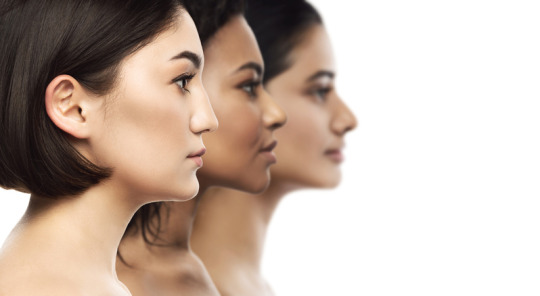
When and why yellow was first applied to people of East Asian descent is rather murky.
The process occurred over hundreds of years. As some scholars have noted, it's not as if there were people with yellow skin. The whole "yellow equals Asian" thing had to be invented. And in fact, there was a time when there was no such thing as "Asian" — even that had to be invented.

Enter Carl Linnaeus, an influential Swedish physician and botanist now known as the "father of modern taxonomy." In 1735, Linnaeus separated humans into four groups, including Homo Asiaticus — Asian Man. The other three categories, European, African and American, already had established — albeit arbitrary — colors: white, black and red. Linnaeus, searching for a distinguishing color for his Asian Man, eventually declared Asians the color "luridus," meaning "lurid," "sallow," or "pale yellow."
I get this bit of history from Michael Keevak, a professor at National Taiwan University, who writes in his book Becoming Yellow: A Short History of Racial Thinkingthat "Luridus also appeared in several of Linnaeus's botanical publications to characterize unhealthy and toxic plants."
Keevak argues that these early European anthropologists used "yellow" to refer to Asian people because "Asia was seductive, mysterious, full of pleasures and spices and perfumes and fantastic wealth." Yellow had multiple connotations, which included both "serene" and "happy," as well as "toxic" and "impure."
He tells me that there was "something dangerous, exotic and threatening about Asia that 'yellow' ... helped reinforce."
Which might explain why the fear that East Asian countries would take over the West became known as yellow peril.

In 1956, Marvel's short-lived Yellow Claw comic featured a villain of the title's name. He was drawn with a bald head, long scraggly beard, slanted eyes and, yes, fingers that resembled claws. True to the name, his skin had a distinct yellow hue.
That was all make-believe. The real-life consequence of vilifying a race included things like the Chinese Exclusion Act of 1882, which banned Chinese immigration to the United States until 1943; the violence against hundreds of Filipino farmworkers in Exeter and Watsonville, Calif., who were mobbed and driven out of their homes by white Americans in 1929 and 1930; and the incarceration of more than 100,000 Japanese Americans during World War II.
For as long as Asians have lived in the United States, white people have been trying to label us: who we are, what we look like and how we should be described. It was also white people who defined our terminology — for many decades, "Orientals" was the moniker of choice. (And when people hurled slurs at us, we've been called Chinamen, Japs, gooks, Asiatics, Mongols and Chinks.)
That started to shift in the 1960s.
That's when the term "Asian American" was born. At the time, it was linked to political advocacy. Yuji Ichioka, then a graduate student and activist at the University of California, Berkeley, who would later become a leading historian and scholar, is widely credited with coining the term.
This period, often referred to as the Yellow Power Movement, was one of the first times these disparate people — Korean Americans, Vietnamese Americans, Japanese Americans, Indian Americans, Laotian Americans, Cambodian Americans, to name only some — grouped themselves under one pan-ethnic identity.
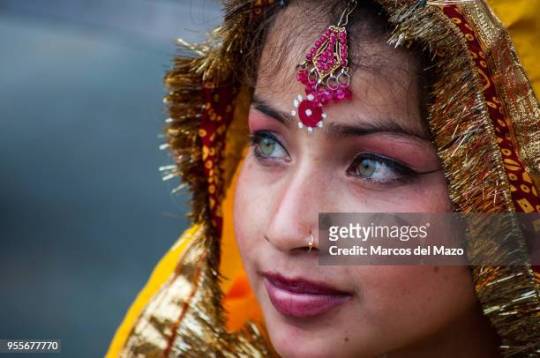
There was power in numbers, which Ichioka knew as founder of the Asian American Political Alliance. In a letter and questionnaire to new members, AAPA made clear that its organization was not just advocating for the creation of Asian American studies courses, but for broader social causes. That included adopting socialist policies and supporting the Black Liberation Movement, the Women's Liberation Movement, and anti-Vietnam and anti-imperialist efforts.
Spurred in part by the activism of the times, the term "Asian American" rose to popularity. It also helped that the Immigration and Nationality Act of 1965 was passed, allowing an influx of Asian immigrants to the U.S.
But over the years, the term Asian American revealed itself to be a complicated solution to the problem of identity.
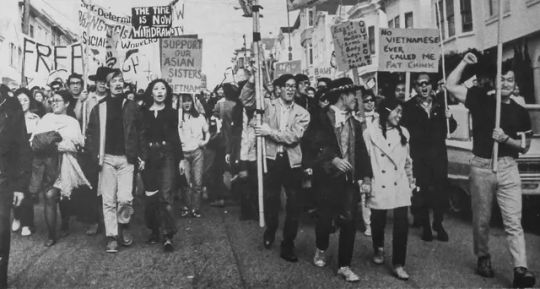
For one thing, most people who technically fit into the "Asian American" category refer to themselves based on their ethnic group or country of origin, according to the National Asian American Survey (NAAS).
Karthick Ramakrishnan, a professor at the University of California, Riverside, and the leader of NAAS, says he and his colleagues found that most Americans think of "Asian Americans" as East Asians.
Karen Ishizuka, who wrote Serve the People: Making Asian America in the Long Sixties, says that "Asian American" is still an important identifier because of the political power it has carried for decades. But it's crucial for people to be educated about what it once meant, she says, because the term has become "more like an adjective now, rather than a political identity."
Ramakrishnan and Ishizuka seem to reinforce why I've been searching for a term like yellow. In all my conversations about this issue, I've found myself remarking how the question of "What about yellow?" feels so hair-pullingly existential. Maybe it's because Asian American seems like it has been watered down from activism to adjective. I find myself wanting a label that cuts a little deeper.
In 1969, a Japanese American activist named Larry Kubota wrote a manifesto called "Yellow Power!" that was published in Gidra, a radical magazinecreated by Asian American activists at the University of California, Los Angeles.
His words were a rallying cry. "Yellow power is a call for all Asian Americans to end the silence that has condemned us to suffer in this racist society and to unite with our black, brown and red brothers of the Third World for survival, self-determination and the creation of a more humanistic society," he wrote.
Kubota wasn't the only one using yellow in a new and different way.
Ishizuka tells me about a bunch of different groups in the 1960s and 1970s: Yellow Seeds was a radical organization in Philadelphia that published a bilingual English-Chinese newspaper of the same name. The Yellow Identity Symposium was a conference at Berkeley that helped ignite the Third World Liberation strikes. The Yellow Brotherhood was an Asian group made up mostly of former gang members in Los Angeles that tried to disband gangs and curb drug addiction. Yellow Pearl, a play on "yellow peril," was a music project started by an activist group in New York's Chinatown.
I call up Russell Leong. He is a professor emeritus at UCLA and was the longtime editor of the radical Amerasia journal. As a kid, he used to make Yellow Power posters in San Francisco's Chinatown.
"Do you call yourself yellow?" I ask him.
"That's an interesting question," Leong says. "If I'm with a group of yellow people like my close friends, I'll call myself a Chink, a Chinaman, a yellow. But in public, I'm not gonna call anyone else that .... it depends what I'm comfortable with. It's the same with my English or Chinese name. Sometimes I'll use my American name. Sometimes I'll use my Chinese name."
Whatever the word, he adds, "I think it's better that we have more words to describe ourselves."
I get it. Despite the incompleteness of any one term, together they can become a powerful tool.
Still, if there were no term like "Asian American" — if it didn't exist, if we gave up on it entirely — then what could we have to anchor ourselves? After all, it's not just about a word; it's about an entire identity.
Ellen Wu, the historian from Indiana, digs into that point: "To circle back to this question of, do we use something like yellow or brown? ... Why do we even feel like we have to?"
Wu acknowledges that we're always craving words that might come closer to encapsulating who we are.
"I think that invisibility — that feeling that we don't matter, that worse, we're statistically insignificant — in some ways really fuels that desire to have a really concise and meaningful way of talking about ourselves," she says.
I pose all of this to Jenn Fang, an activist and writer who runs the appropriately-named blog Reappropriate.
She's not so convinced that yellow would resolve the issues that plague Asian American. It might be a useful identifier if yellow was used very intentionally and people knew its history, she says. But it could also fall into the same traps as Asian American. With ubiquity, it could eventually lose its power.
Fang also thinks that if people were to identify as yellow, there would be more people staying in their own lanes, so to speak — that, say, East Asians who call themselves yellow might not advocate on behalf of Asians who call themselves brown.
"Are you reclaiming the slur, or reclaiming our history?" Fang asks me. "The thing I'm concerned about is — is [yellow] a truly reflective way of talking about the East Asian American experience? Is yellow more nuancing? ... Or more flattening?"
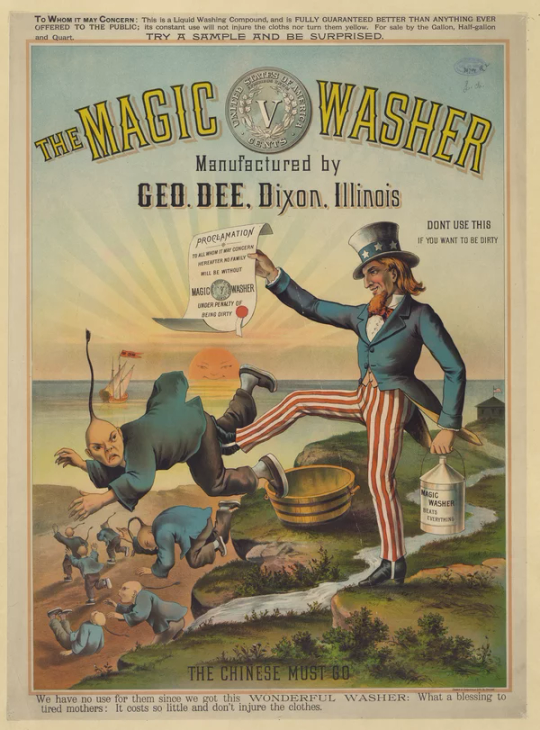
In the pinnacle of the civil rights era, activists used yellow as a term of empowerment — a term they chose for themselves. In some ways, I'm still seeing that today.
When the director of Crazy Rich Asians, Jon Chu, wanted to include a Mandarin version of Coldplay's song "Yellow" in a pivotal scene of his movie, some people were concerned that including it might not fly in such a high-profile movie about Asians. But that was exactly Chu's point. He wrote a letter to the band pleading his case — he wanted to attach something gorgeous to the word.
"If we're going to be called yellow," Chu wrote, "we're going to make it beautiful."
I can't help but think back to a group of people I spoke to late last year.
The Yellow Jackets Collective is an activist group, the name an echo of the 1960s. They're four people in New York City who identify themselves with a wide swath of terms, in addition to yellow: she/her, womxn, brown, Asian American, femme, child of Chinese immigrants, Korean American, 1st gen., first gen. diasporic and "collaborating towards futures that center marginalized bodies."
I send them an e-mail. "Why yellow?"
They point out that they don't just walk around the world calling every East Asian person they meet "yellow."
"Identity ideally is about you and how you feel and what you believe has shaped you," Michelle Ling responds.
I let Ling's words percolate. I don't know if I'll walk around in the world calling myself yellow — maybe to people who have similar experiences to mine; certainly not around people who've flung slurs at me.
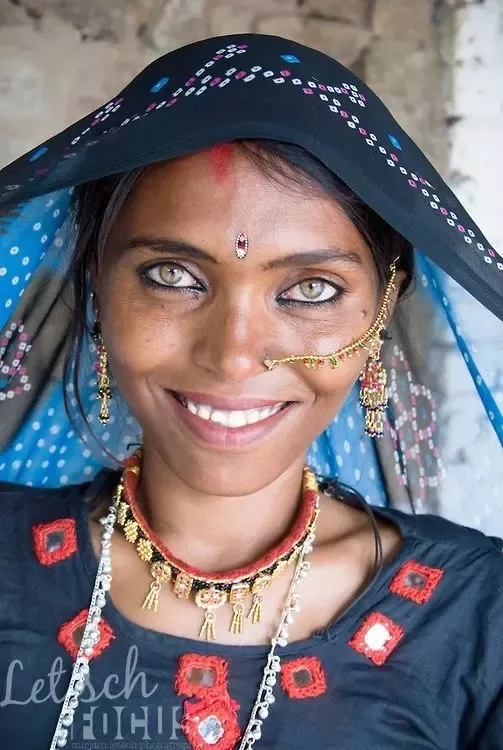
Even so, having different words to choose from is itself a comfort. Having yellow in my arsenal makes me feel like my identity doesn't hinge on just one thing — one phrase, one history or one experience.
After a back-and-forth with the group, something they've written stops me in my metaphorical tracks. It's from the Yellow Jackets mantra; a snapback comment that I can't help but appreciate:
"We say Yellow again because at our most powerful we are a YELLOW PERIL and those who oppress us should be afraid. We are watching you. We are making moves."

In “The Travels of Marco Polo,” the people of China are described as “white.” Records left by eighteenth century missionaries also report the skin color of Japanese and other East Asian people as clearly white. Yet in the nineteenth century, this perception quietly gave way to descriptions as “yellow.” In travel books, scientific discourse, and works of art, portrayals of East Asians began presenting them as having yellow skin. What happened in between?

In his 2011 book “Becoming Yellow: A Short History of Racial Thinking,” National Taiwan University professor Michael Keevak delves deeply into the origins and history of how and why East Asians went from being seen as “white” to being classified as “yellow.”
The first suspect implicated in applying the “yellow” label to East Asian faces is the famed Carl Linnaeus (1707-78). At first, Linnaeus used the Latin adjective “fuscus,” meaning “dark,” to describe the skin color of Asians. But in the tenth edition of his 1758-9 “Systema Naturae,” he specified it with the term “luridus,” meaning “light yellow” or “pale.”

It was Johann Friedrich Blumenbach (1752-1840) who went beyond the coloring ascribed by Linnaeus to apply the completely different label of “Mongolianness.” Regarded as a founder of comparative anatomy, the German zoologist did more than just use the Latin word “gilvus,” meaning “light yellow,” to describe East Asian skin color: he also implicated the Mongols, a name with troubling and threatening connotations for Europeans with their memories of Attila the Hun, Genghis Khan, and Timur.
While the references remained anomalous at first, travelers to East Asia gradually began describing locals there more and more as “yellow.” By the nineteenth century, Keevak argued, the “yellow race” become a key part of anthropology.
But the yellow label came associated with discrimination, exclusion, and violence. Just as no one in the world is purely white or black, neither does anyone actually have skin that is deep yellow. By “creating” a skin color and investing traits such as “Mongolian eyes,” the Mongolian birthmark, and mongolism (the old name for Down syndrome), Westerners made the perceived yellow race synonymous with abnormality. They also responded to the arrival of immigrants from Asia by sounding the alarm over the “yellow peril” - a term with a whole range of negative associations from overpopulation to heathenism, economic competition, and political and social regression. The hidden agenda of this racial color-coding becomes apparent when one considers who benefits from a hierarchy that places “yellow” and “black” beneath “white.”
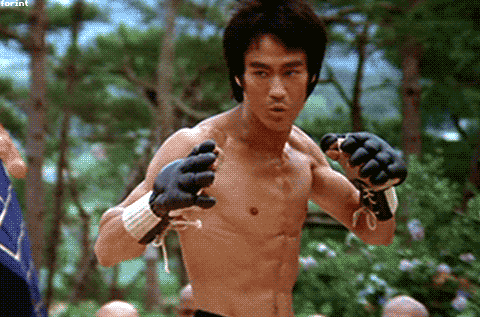
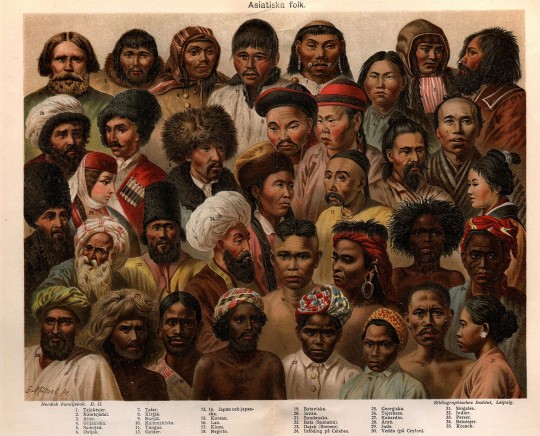
#kemetic dreams#asian#Blumenbach#german#european#exonym#banning exonyms#yellow#white#yellow people#black#black people#racist#conservatism#political#american politics#liberalism#civil rights#racist words#bruce lee#brownskin#brown skin#asian American#asian american literature#asian american history#asian heritage month#asian american author#asian american pacific islander heritage month#stop asian hate#aapi
10 notes
·
View notes
Text
Ken Paxton will bash in the doors of 80 year old ladies, before 6 in the morning, who are registering legal American citizens to vote. He will sue the Biden administration over an endangered lizard and his lack of giving a damn if it seems to exist. Him and his fellow fascist in arms (definitely not legs) Greg Abbott will thread the Rio Grande with razor wire and laugh as immigrants drown in it. Paxton will go on Bannon’s show and chuckle and brag about how he knocked 2 million Texans off the voter rolls before the 2020 election. Those 2 are the definition of tyranny. The example of governing for the few, and screw the rest, particularly those with brown skin. It is Paxton who has attempted to allow government agencies to obtain women’s medical records to make sure they didn’t have an abortion. Pairing with Oklahoma have suggested even patrolling state lines to make sure women aren’t leaving the state for reproductive care.
It sounds like some shit out of a dark thriller but these are all policies, bills, and proposals from Texas lawmakers.
Funny thing is, the minority population in Texas is hardly a minority. It’s this draconian rule by these white Christian nationalists who suppress votes, engage in intimidation tactics, and break the law in any way they can get away with.
Now, not wanting to face any criticism, or encourage any sympathy, they won’t release data in maternal fatalities.
Paxton and Abbott are just sick, terrible human beings. As unamerican as one can get. I truly hope it burns when they pee.
#politics#texas#ken paxton#texas news#election 2024#trump is a threat to democracy#fascisim#greg abbott#losers#freedom#freedom of religion#free speech#fraud#traitor trump#vote blue#donald trump#republicans#news#the left#hope#mexican american#love#liberal#change#democracy#vote democrat#fuck maga#free press#the future#fuck racism
3 notes
·
View notes
Text
Leftist, antiracist activists like to criticize the police, but something even scarier than police brutality and corruption has been happening in the community near me.
There is a significant portion of the population in suburban Delaware that harbors both deeply racist views, and anti-police sentiment. These people tend to have far-right views and a deeply punitive mindset; Delaware is a "blue state" and has been relatively progressive about its police policies, moving away from overly punitive policing in recent years.
And some people are irate about it. There are social media posts complaining about out of control crime.
This is woefully out-of-touch with what is actually going on. Delaware had a record low rate of violent crime in 2023, following a brief, temporary surge during the pandemic. Delaware has reduced their prison population too. Statewide total crime has also decreased from 2018 through 2022 as reported by the state, with the largest decrease in drug offenses and a relatively smaller decrease in property crime.
People though have started posting stuff on social media with blurry pictures of people from doorbell cameras, dash cams, and other low-quality cameras. Most of the people in the photos are children or young teenagers. Some of them are employees at work just ringing people's doorbells for presumably valid reasons, such as utility workers, county tax assessers, or delivery people. Occasionally people post photos catching people in the act of a crime, like breaking into a car or damaging property.
A lot of the photos are so blurry it would be hard to definitively ID someone from them, and thus easy to mistake someone's identity. And they're sharing these things on social media and calling for a sort of vigilante justice. And predictably, most of the people being targeted are dark-skinned, which is significant because Delaware is overwhelmingly (65%+) non-hispanic white. It's obvious that these posts are tainted by racism.
When a crime is involved, a lot of people suggest to go to the police, but any time the police are brought up, people start trash talking the police. "The police don't do anything". "Cops are useless." and stuff like that. People are really angry and irate and viciously attack anyone who advocates going to the police.
There is this idea that the police do nothing and the only way to deal with crime is to "take things into your own hands". I don't even know what these people want, because they won't come out and say it, but it's really scary. People are talking about circulating people's pictures, calling them "criminals" and that they need to be "punished". Many of these people, from their other posts, are open about owning guns.
When people talk about defunding the police or abolishing the police, I think it's important to ask the question of what will take their place. As corrupt an institution as the police in the US are, I think it's important to remind ourselves that there can be things worse than the police, and that sometimes, in a power vacuum, whatever institution self-organizes may be worse than the one that existed before.
One of my ancestors was killed by lynching in the south, because he was seen as sympathizing with the Union in the civil war. I also have directly experienced harassment in public for being gender-non-conforming, and also a slew of antisemitic hate comments online targeting me because of my Jewish name, and also sometimes because of my political stances.
I know where this leads and it's not good. People like me (and probably you, reading this) are vulnerable. I belong to multiple groups that would be targeted if vigilante violence became a thing.
I'm white, a US citizen, and relatively well-off. I can't even imagine how much more vulnerable black and other dark-skinned people, immigrants, and poor people would be than myself. But I know they are going to be even more vulnerable.
Take from this what you will. I can tell you what my take is:
We as a society have a deep need to root out both racism and the punitive mindset, and achieving these goals is much more than just moving away from formal policing.
Removing the institution of the police while retaining the racism and the punitive mindset risks devolving into a hellscape of vigilante justice shaped by racism and other biases
In the interim, a functional, even if flawed, police system, with some semblance of respecting due process, is a better status quo than a completely broken or absent police in which vigilante justice (with no due process) takes hold
This is why I am hesitant of rhetoric that universally demonizes the police or calls for immediate or full police abolition. A lot of people see police abolition as a leftist take, but as my recent experience shows, this movement may find an unlikely and unhealthy ally in far-right sentiments, and there is a huge danger in allowing these sentiments to take hold.
When elements of abolition (such as decarceration and decriminalization) take hold, it often strengthens far-right anti-police sentiment, because people start seeing the police as allied to the left, which is ironic because the left often still sees the police as allied to the right.
I haven't seen anyone in police abolition circles talking at all about these occurrences, let alone propose any solutions.
If we want to achieve police abolition, we need a path forward that keeps these unsavory elements under control. And I'm struggling to see that path, which is one thing that makes me think we may need to put the brakes on some of the boldest pushes of the abolition movement.
2 notes
·
View notes
Text
When Donald Trump talks about undocumented immigrants, he often brings up genetics.
Immigrants are “poisoning the blood of our country,” he said at a rally last year.
“Many of them murdered far more than one person, and they’re now happily living in the United States,” he said earlier this month. “You know, now a murderer, I believe this, it’s in their genes. And we got a lot of bad genes in our country right now.”
The former president’s language underscores a larger trend, experts tell STAT. The eugenics movement is once again taking center stage in the U.S. — both in the immigration policies and rhetoric promoted by Trump, and through a rise in race science in academic literature.
Eugenics — the pseudoscientific idea of fixing social problems through genetics and heredity via policies ranging from selective breeding to forced sterilization and genocide — was popular at the turn of the 20th century, before the devastation of the Holocaust quelled public support for it. The reasons for its resurgence include an increase in funding of race science from private donors, as well as proponents of scientific racism and white nationalists manipulating the push to make science more public.
Even well-intentioned scientists have fed into this shift by promoting genetic determinism — the idea that genes are the primary driver of traits and behaviors — and by platforming problematic work in the name of academic freedom.
“I wasn’t surprised that people are being demagogic about this stuff, but I am a little surprised that they’re so clearly not even hiding [it],” said Paul Lombardo, a professor of law at Georgia State University who has done extensive work on the legacy of eugenics. “This is not just saying the quiet part out loud. This is coming up with quotations in which, instead of using quotation marks, you’ve got swastikas at each end of the sentence.”
‘Bad genes’ and the birth of eugenics
Trump is frequently accused of racism, but the fact that he is embracing eugenic thinking has not drawn sufficient attention, according to Shannon O’Brien, a political scientist at the University of Texas, Austin, who has written a book on eugenics in American politics.
While racists harbor hatred for others because of their ethnicity or the color of their skin, eugenicists take it a step further and “like to legislate people out of existence,” O’Brien said. “They are OK with sterilization. They’re okay with extermination, and they believe that certain groups are superior and it’s OK to enact things that make it difficult for other ones to exist. I find that far scarier than racism.”
Asked about Trump’s rhetoric and the eugenics movement and his remarks about “bad genes,” Karoline Leavitt, the campaign’s press secretary, told STAT, “President Trump was clearly referring to murderers, not migrants.’’
The former president also has a history of statements suggesting that certain people are genetically superior. A 2016 documentary pointed out Trump’s father, Fred, introduced him to “racehorse theory” as a child — the idea that “that if you put together the genes of a superior woman and a superior man, you get superior offspring.” He’s used this idea to promote his own intelligence as well. “I had an uncle who went to MIT who is a top professor, Dr. John Trump. A genius. It’s in my blood. I’m smart,” he told CNN in 2020.
This way of talking about genetics is rooted in a long history that begins with the English anthropologist Francis Galton, who took his cousin Charles Darwin’s theory of evolution and applied it to humans, first using the term eugenics in 1883. The nascent field of eugenics matured into a full-fledged field of study in the United States. Much later, in the 1990s, the sequencing of the human genome inadvertently created a new surge in eugenics — emboldened by the idea that scientists could isolate genes responsible for complex behaviors, like poverty, crime and intelligence.
How companies like 23andMe bolstered genetic determinism
Those affiliated with the Human Genome Project hoped sequencing the genome would end notions that genetics created significant differences in different groups — “that it would lead us to this post-racial world,” said Aaron Panofsky, the director of the Institute for Society and Genetics at the University of California, Los Angeles.
“But it turns out that both scientists and the public spend all their interest in the 0.1% of genetic variation that makes us different, not the 99.9% that makes us the same.”
In promoting their research to the public and getting research funding from the government, geneticists often hyped up the role genes play in people’s lives. The Human Genome Project “was a huge public undertaking,” said Emily Merchant, a historian of science at the University of California, Davis. “It was almost $3 billion and took more than a decade to complete. So it needed a lot of popular support. The scientists who were trying to generate that popular support did it by promoting genetic determinism.”
This sentiment persisted in ensuing years because of popular genetic testing companies like 23andMe and Ancestry.com, which marketed its products with the premise that an understanding of genetics held the secret to good health and could quantify people’s sense of belonging to racial or ethnic groups.
In the early 2010s, there was another shift in how mainstream academic circles discussed ideas that intelligence was genetic or that race had a biological basis. Richard Lynn, a psychologist who claimed that people from certain countries had lower IQs, promoted a biased dataset on IQ differences between countries that became increasingly widespread in academia. Another theory, called “differential K theory,” began to circulate around this time, stating that Black people have lower IQs and are more aggressive.
“The national IQ database, differential K theory, they should have died the death bad science deserves to die. They have no scientific merit,” said Rebecca Sear, an evolutionary behavioral scientist at Brunel University who has documented the resurgence in eugenics in demography. “They’ve both been extensively critiqued. They are both currently thriving in the academic literature.”
While controversial among the scientific community, ideas like Lynn’s continued to spread in academia, in part because of the ethos of academic freedom — the idea that scholars should be able to research and debate any issues in their field, and that rejecting a paper based on problematic findings is tantamount to censorship.
“That’s a very, very problematic argument, but I think it is quite widespread,” Sear said. “Academic freedom isn’t the freedom to say literally anything in an academic forum. It’s the freedom to say anything with a sound methodological basis.”
While these ideas lacked scientific rigor, Sear explained, they were often not intended for other scientists. “Scientific racism really is not aimed at academia. It’s aimed at the outside world. And this, I think, is why it’s so often such bad science,” Sear said.
The appropriation of open science
The open science movement around this time also proved to boost the spread of flawed research on race, ethnicity, and genetics. Academic journals increasingly were publishing papers without paywalls, so anyone could access them, and often requiring the data underpinning research to be available.
Some scientists had also begun posting early drafts of their work, called “preprints,” on public forums. By doing science in the public square this way, people with explicit political agendas could access, manipulate, and reinterpret published research in a way that sometimes took academics by surprise.
Online, white nationalists used popular genetic testing websites to prove how white they were, and reanalyzed scientific data with a bent to affirming biological differences between races. They also seized on uncertainty among biologists about how to discuss race in the academic literature. Discussion forums on the subject might lean on anti-science conspiracy theories, but users could sometimes make sophisticated arguments about statistical uncertainties or the distinction between correlation and causation.
“They read both against and with the scientific literature, and that’s the way in which it becomes a very complicated dance that they sometimes make,” said Panofsky, who has studied the ways that far-right movements weaponize genetics.
The solution to the weaponization of genetics isn’t gatekeeping research, experts studying the issue agree. But, they say that academia hasn’t confronted the ways science can be used to embolden bigotry.
“We have basically a metric for how much Nazis like your research,” said Jedidiah Carlson, a population geneticist at Macalester College who led an analysis of how preprints circulate among right-wing extremists online. But it’s not a feature many are interested in. He wants to see researchers more attuned to the long-term impact of their work.
Incentive structures in research are also responsible for the continued popularity of research on topics like the links between genetics and intelligence or educational attainment, Carlson said. It’s “easy to get money for it, because you can say this has immediate policy implications for education and immigration policy … It’s just treated as this generic ‘apolitical’ research when it never has been.”
Challenging the idea that genes are ‘in the driver’s seat’
The failure to deeply engage with the dark history of eugenics and the way it’s informed a number of academic fields is linked to current political hostility directed toward immigrants, according to Marielena Hincapié, an immigration scholar and lawyer at Cornell University who hosted a symposium on the 100-year legacy of eugenics and the Immigration Act of 1924.
She points to recent attacks on immigrant communities carried out by people that believe in the Great Replacement Theory, a conspiracy that posits there is a concerted effort to diminish the power and influence of white people in the United States. The gunman behind one such attack, in Buffalo, New York, directly cited genetics research in his thinking.
The incident sparked some soul searching within the genetics community, which has also pushed back on problematic use of its research. In one case, a genetics consortium challenged the use of its data by a private company to screen embryos. On another occasion, a now-defunct app claimed it could test users on whether they had genes associated with same-sex sexual orientation, drawing on a paper published in Science. That prompted a protest petition signed by more than 1,600 scientists.
There’s also growing interest in the scientific community in how social determinants, such as economic policies, racism, and climate change, shape people’s health, and in the field of epigenetics, which studies how the environment affects gene expression. These paradigms open up an understanding that “genes are not necessarily in the driver’s seat, but they’re in an interactive relationship with a whole bunch of other factors,” said Panofsky. “They seem to open a door to a post-deterministic biology and genetics.”
Even so, the field has yet to truly rethink its buy-in of the idea that genes play a central role in people’s abilities and behaviors, Panofsky said. That thinking can inadvertently support the kind of problematic rhetoric Trump has applied to immigrants. While much of the U.S. has moved on and forgotten about its eugenic past, the country hasn’t done the work to refute the ideas it made so popular.
“We presume that we’ve done the work of rooting these matters out of our society,” said Michele Goodwin, a professor of constitutional law and global health at Georgetown Law. “But that presumption is proving to be quite thin and weak in these times.”
Just over 100 years ago, eugenicist Harry Laughlin testified before the U.S. House of Representatives that “The character of our civilization will be modified by the ‘blood’ or the natural hereditary qualities which the sexually fertile immigrant brings to our shores.” His argument wouldn’t be out of place today.
#Trump’s talk of ‘bad genes’ is rooted in eugenics. Experts explain why it’s making a comeback#‘Instead of using quotation marks#you’ve got swastikas at each end of the sentence’#nazi#eugenics
7 notes
·
View notes
Text










The idea of boroboro is that it’s your junk-est clothes. It’s da clothes you weed in not go to temple or obon in.
But arts like sashiko and boro pro are now being lauded by white people who are buying up and increasing value of these pieces.
Which is great to a point.
The point being are we going to adknowlge that this is a Buddhist Japanese American Diaspora and Japanese Diaspora art of plantation workers, and slaves who made their clothes last?
These stitches are practical because they reinforce the fabric. And the indigo repells insects. The stitches on the outside are so they don’t bother skin. Because when we’re working shouldn’t we be comfortable?
What is the answer to fashion based slavery is the huge question my exhibit asks.
And for me the answer signs in ASL: its complicated/it depends.
In fashion I think if we all learned how to repair something in our traditoways and were encouraged to repair one thing we care about, or hire someone to and pay them well, that we could reduce waste, pollution, while also adknowlging that fast casjio fills a need for affordable attractive clothes that fit well.
2. Introducing the Ladies: Each Outfit and what they mean
BoroBoro Britney
She’s lined with a brides Maid robe of rayon blend that is made to emulate satin. It’s peak fast fashion, made to be tossed once the wedding is done. It found it’s way to a Goodwill, the largest one in Seattle off Jackson and that found its way to me.
The color, champagne is peak wedding. For most Japanese women who worked in the fields, they came as picture brides, mostly unwillingly, or coerced.
For my family, and my great grandmother it was unwilling.
But the US’s racist policies refused to let families immigrate. Like how the policies are now, they separated families if you had one. It was illegal to marry other ethnicities. And your children would be considered not legitimate by both cultures.
I’m saying this as a bi-racial Japanese person. Even today, I was heavily bullied as a child and ostracized, while being fetishized.
The main fabric is themed off a fabric I designed. It’s too expensive to make the entire Kimono out of that. Which is the concept of BoroBoro itself. You don’t have enough money to have good fabric so you reinforced the fabric while you repair it. It’s a supplemental kind of sewing that uses what you have.
If you think it looks a lot like quilting, you’re right! Quilting and boroboro both use scrap fabric and stitches to bind and sandwich fabrics together.
The main fabric is a dark royal blue that I designed in PicsArt and Instagram Layout on my Google Pixel 5 Android Phone. I designed the fabric to mimic the nights sky in Haiku Maui and from Halēakala. The lei are wound with lilikoi flowers and lion fish and Kamehameha butterflies and sparkles to symbolize fire and metal. It's meant to show the 5 elements wound together in harmony and balance.
The edges of the fabric are hand dyed in indigo but it’s splotchy.
6 notes
·
View notes
Text
By: Tom Slater
Published: Jul 8, 2023
We need to stop saying identity politics, wokeness, or whatever else we want to call it, is progressive. We need to stop referring to the people who are actively reviving racial, misogynistic and homophobic thinking – under the guide of being ‘racially aware’ and ‘trans inclusive’ – as left-wing radicals. They are anything but. These people are reactionaries and bigots. And it’s high time we started naming them as such.
All this was brought into sharp relief this past week or so. First, with the monumental US Supreme Court ruling striking down affirmative action in university admissions.
Everyone sane knew it had to go. This system, set up to boost the prospects of the descendents of American slaves, disadvantaged by generations of oppression, had become utterly dysfunctional – benefitting only a sliver of well-to-do black Americans, many of them first- or second-generation immigrants, who therefore had no familial connection to the evils of US slavery and segregation.
Worse than that, it was justifying the most grotesque racial discrimination. The biggest victims of this were Asian Americans. Too many of them were getting the grades to get into the Ivy League, they were way above their allotted quotas, and so the racial bean-counters at top colleges cooked up increasingly crude and racist measures in order to push the numbers down.
This led to the most perverse trade-offs, which no one could reasonably defend. As Wilfred Reilly put it pointedly on spiked this week, ‘affirmative action in practice often involved the well-fed son of a Jamaican American or Colombian American dentist being given a 300-point test-score advantage over the daughter of a Vietnamese immigrant shopkeeper’.
It had become abundantly clear that these race-based policies were distracting attention away from the class inequalities that blight Americans of all skin pigmentations – inequalities that are left completely untouched by shuffling the deck a bit at elite colleges. What’s more, they were giving a leg-up to wealthy black and Hispanic kids at the cost of the truly disadvantaged.
And yet, the response to the striking down of this dysfunctional and discriminatory system has been one of hysteria among the cultural elites. The Supreme Court ruling has been mourned by self-identified liberals, progressives and even socialists as a win for ‘racism’ and ‘white supremacy’ – even though its most immediate beneficiaries will be Asians.
Affirmative action wasn’t the brainchild of woke activists, of course. As Kevin Yuill points out, it was introduced by one Richard Nixon as a ‘technocratic solution to racial tensions’. But it has certainly become a sacred policy for a woke American left that now openly insists, in the words of Ibram X Kendi, that ‘the only remedy to past discrimination is present discrimination’ – and that Kingian colour-blindness is actually a bigots’ charter.
These people have disappeared so far up the fundament of racial identity politics that they now see discrimination as equality and colour-blindness as racism – and a ruling that insists students be judged by the content of their character rather than the colour of their skin as a victory for white supremacy.
If you needed any more proof that contemporary anti-racism has utterly lost its way, drink this in. These people are now the primary political force that is promoting racial thinking, racial consciousness, racial discrimination even, in Western public life today. And yet somehow they still get away with posing as the inheritors of the civil-rights movement.
If you’re a gender-critical feminist, this may all sound faintly familiar – for an almost identical con trick is now being pulled off by ‘LGBT+’ activists. For years now, women’s rights and spaces have been violated in the name of trans inclusion. Plus, a vicious homophobia has been unleashed against those who dare to insist that being gay means being attracted to someone of the same sex rather than the same ‘gender identity’.
This brings us away from America and affirmative action and to another – much less historic, but no less revealing – legal battle that has just concluded in the UK.
On Thursday, the LGB Alliance – the only UK charity focussed solely on same-sex-attracted people – successfully defended its charity status at a tribunal. Mermaids, a controversial trans-youth charity, had launched a legal challenge aimed at stripping the LGB Alliance of its charitable privileges on the grounds that it was ‘impeding the work of registered charities that work for the benefit of transgender people’.
In truth, this was a thinly veiled attempt to silence a formidable opponent. The leaders of the LGB Alliance, themselves veterans of the gay-liberation movement, are trenchant critics of gender ideology. They have bravely exposed the homophobia underpinning much of today’s trans activism, from the pressure it heaps on gay and gender-nonconforming kids to ‘transition’ to the pressure it heaps on lesbians to sleep with biological, be-penised males who ‘identify’ as women and lesbians.
Thankfully, the judges on the tribunal panel saw right through it. The LGB Alliance has been vindicated. And Mermaids has left itself exposed to more than just charges of hypocrisy, complaining about being ‘silenced’ by a charity that it was actively trying to close down. The tribunal led to a harsh light being shone on its own practices. In December, a statutory inquiry was opened into Mermaids, amid allegations it had sent breast-binders to girls behind their parents’ backs.
But this victory came at some cost. The LGB Alliance had to raise and spend £250,000 to fight for its very existence – money it could have spent on campaigning. It was also emotionally gruelling at times. At one of the hearings, LGB Alliance co-founder Kate Harris broke down when she was asked to define what a lesbian is. This veteran of gay-rights politics was essentially being asked to defend the notion that lesbians – that is, biological females who are attracted exclusively to biological females – actually exist. This is how much trans ideology has deranged us.
Shamefully, this campaign to shut down a gay-rights organisation – indeed one of the few organisations that is still devoted to gay rights – was cheered on every step of the way by ‘LGBT+’ activists, those who see themselves as the successors to the Stonewall rebels and the Gay Liberation Front. That Bev Jackson, another LGB Alliance co-founder, was also a co-founder of the Gay Liberation Front never seemed to phase her haters.
There is this idea among sections of the anti-woke, ‘post-liberal’ right of political commentary that gender ideology is the logical endpoint of progressivism. That casually sterilising kids and putting male rapists in women’s prisons is just left-wingers doing what left-wingers have always done – throwing off the old, in quest of liberation, regardless of the consequences.
This has always struck me as bullshit. Being left-wing doesn’t mean welcoming almost any radical change to how society is organised, no matter how demented it is. There is also nothing progressive about believing that up is down and 2 + 2 = 5. Nor is there anything liberatory about gender ideology – a movement that has essentially been built on censoring dissenters. It is a campaign not for liberation, but for validation and recognition.
The truth is much simpler. Namely, that this thing we call wokeness, while it might present itself as progressive and left-wing, is really just bigoted, reactionary ideas about race, gender and sexuality, dolled up for the 21st century. All those accusations of racism, homophobia and misogyny, flung by identitarians with increasing abandon over recent years, were just one big, wailing act of projection.
The wokesters may not realise it, but in the fight for a truly anti-racist, egalitarian society they are firmly on the wrong side. The side that mourns the demise of racial discrimination in universities and campaigns tooth and nail to get gay-rights groups shut down. Whatever we might want to call these people, ‘progressive’ really isn’t it.
#Tom Slater#regressive#progressive#progressivism#neoracism#bigotry of low expectations#antiracism as religion#antiracism#woke homophobia#college admissions#affirmative action#racial discrimination#LGB Alliance#gender ideology#queer theory#homophobia 2.0#cult of woke#wokeism#wokeness as religion#woke#religion is a mental illness
13 notes
·
View notes
Text
The "there's nothing wrong with Biden" camp really needs to quit asking me to source my disataste for the guy, because every time I do, I learn something else about him that I like even less.
I learned when it happened that Biden scapegoated southern migrants in his final State of the Union of his first term, despite previously and currently running against the guy who's entire campaign started with calling hispanic people criminals. Despite his entire electoral strategy being "I know I suck but I'm not this guy", his current plan of action is to be as much like that guy as he possibly can. That's bad enough. Calling mexican people (or, let's face it, every brown-skinned person in the US who doesn't look like any other racialized people, because they get the same shit even if they aren't mexican) "dangerous illegals" and promising to shut down the southern border if Congress lets him, after working on Trump's border wall for him is bad enough for the genocide guy. To know that there was a widow for a racially motivated attack, brought there to serve as a reminder for the increase in racialized violence against this community in the wake of the president who's entire major foci of racism was targeted to this community, present in the audience as he said this, is even worse. To then learn that he brushed it off when pressed with a "well he shouldn't have been here anyway" just pisses me off further.
I knew Biden didn't close thr migrant concentration camps. Bad enough. I was demanded a source. When I provided one from "russian- biased" Al Jazeera, and thus it couldn't be trusted by liberals, I found Reuters. Then I learned he sold them to private prisons, so that he could claim he was closing private prisons because he promised it on the campaign trail. Literally scrubbed the name, let the profiteers keep profiting, and labelled it closed. That is Trump filing off the serial numbers levels of bullshit and he did it.
https://www.reuters.com/world/us/biden-vowed-reform-immigration-detention-instead-private-prisons-benefited-2023-08-07/
As a trans-enby of color, I don't think it's acceptable to shelter a racist just because he gave a tepid shrug in regards to whether or not I should be consumed for protein. That isn't enough to justify the harm this man has explicitly sent the way of racialized peoples. Ues, for the sake of argument here, I am ignoring what his policing policies have done for black people and what his zionism has done for arab people. He's gonna flip on the LGBTQ community, I have zero doubt at this point. He did it to hispanic peoples, and he campaigned on standing up for them. Now he's campaigning on.. well he's camapigning on nothing really. But the queer community, and I suppose the asian community, is about all that's left for him to flip on now isn't it?
I am appalled that neoliberalism has shit the bed this badly and infuriated that then its adherents have the audacity to try and weaponize part of my identity to justify the bastard explicitly trying to kill another part of my identity as any way acceptable. And no, "other guy is gonna be worse" isn't an excuse anymore either. You chose this man. You didn't have to. But you were too cowardly to challenge the status quo and your perceived comfort, because you didn't realize how bad it truly was out here for the people whom neoliberalism has worked tirelessly to make invisible to you. You could've voted for someone else in the primaries. You could have given us someone else. You could have motivated your white friends to actually engage with the political process even a little bit and move them into voting for what they keep claiming to want (even if they don't vote that way). You chose not to. You chose instead, to bully people who have hard-line prinicples on human rights they won't cross just because some ancient white guy feels entitled to playing big boy power-broker. I said it when I voted for the bastard in 2020 that "it doesn't even feel like he wants thos position. It feels like he's campaiging because he expects to get it, like some office suckup wandering late onto a meeting because they figure the promotion is a lock for them." Political fatalism masquerading as "maturity".
Vote for this man or don't. I do not care at this point. If you do, I do not consider you an ally to be trusted. You're in a comfy enough position to feel that there's "no good reason" for marginalized peoples to reject this man, when other guy is "so much worse"? Go on babe enjoy your time, just know you're showing a true face you might not be aware of. Biden feels entitled to power even if he has to kill thousands of children and be a smug prick when called out on it to do so, and the liberals gave it to him, showing their ass the entire time. Revealing their actual contempt for progress and human-rights. Embarassing.
5 notes
·
View notes
Text
I had one of those Moments today while socializing with a small group of friends I've made among faculty at my university (pretty much the only friends I've made since moving here, actually), who are a very SJ-ideology-right-down-the-line bunch as is most often the case in academia (they're all in the humanities, which doesn't help). The two most aggressively SJ of them, who frequently make references to how racist restrictive immigration policies are and how racist everything is in general, are a couple from Canada. Today they were ranting about the history of demographic issues in Quebec. I know next to nothing about this, but I understand from them that many decades ago the French spoken in Quebec was in danger of being supplanted by English and so measures were taken to get more immigration from French-speaking countries, then when that turned out to include a bunch of African or otherwise non-white countries the government went, "Wait, no, we didn't mean those kinds of people" and managed to turn this into a large influx of French people, mainly from Paris, instead. But the problem with that is that Parisians are used to paying tons of rent (because, well, Paris) and so were willing to live at a much higher cost than was the standard in Quebec, eventually raising rent for everyone there. Those two friends were vehemently denouncing this trend and the harm it did to the Quebecois who were already there; at one point one of them said that she "hated" the Parisians in Quebec for this.
And I was sitting there thinking, "Isn't this, in economic terms, just a variation on one of the main basic cases American conservatives make against immigration? Which I know according to you just entirely boils down to hating darker-skinned people, but if you listen to the genuine concerns some of the anti-immigration folks have, it's about how people from a lot of less privileged countries are used to lower wages so they'll accept a bunch of menial jobs for lower wages than Americans are willing to get for those jobs, and then the immigrants will cause wages to go down for everyone. In this case, instead of talking about how little people are willing to be paid, it's about how much people are willing to pay, but your 'hating' Parisian immigrants for what they're doing to the economy seems to be a very similar principle, no?"
And of course, as almost always, I kept my thoughts to myself, because I value not injecting tension between myself and some of the very few true friends I have in this geographic region.
#social justice#racism#quebec#french language#immigration#how would one frame the the difference between the two?#in terms of supply-side vs. demand-side or something?#please feel free to inform me on Quebec or on eco terms#i try for certain boundaries on complaining about friends here#and i'm pretty close to crossing that line with this one
16 notes
·
View notes